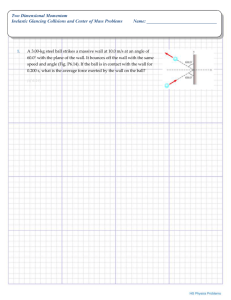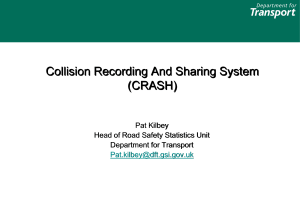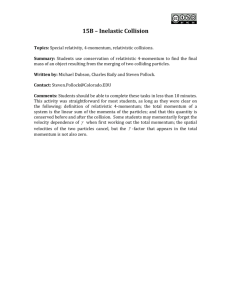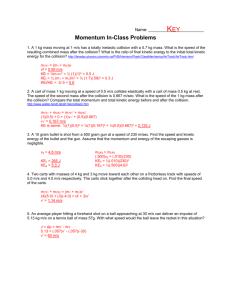Hard-Sphere Molecular Dynamics
advertisement
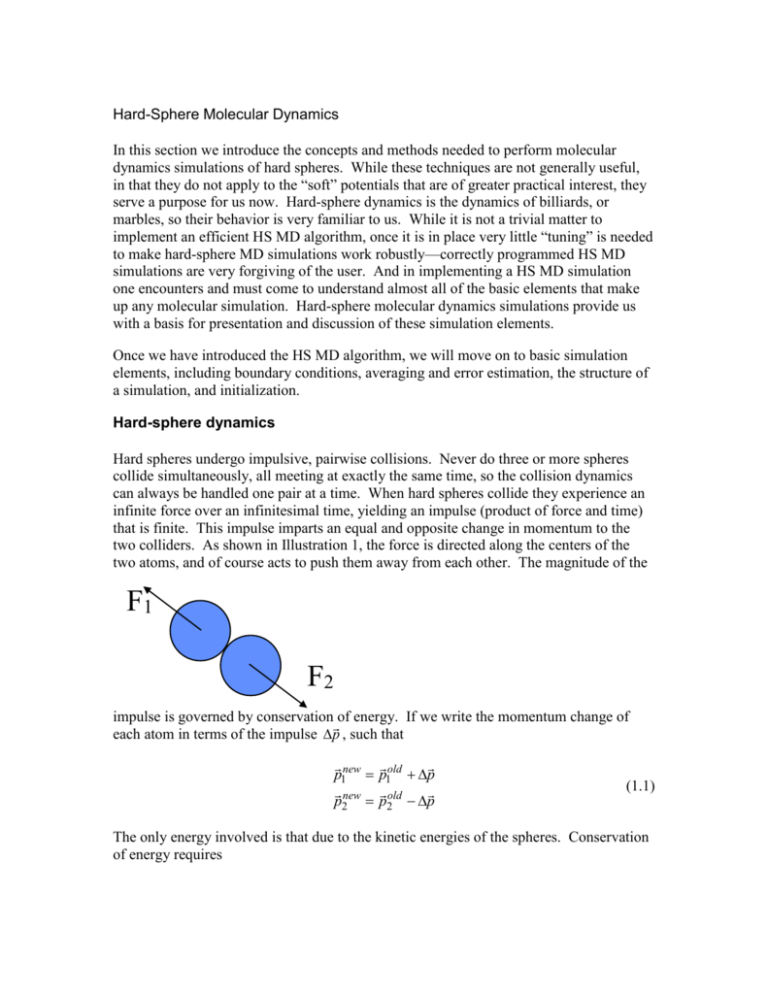
Hard-Sphere Molecular Dynamics In this section we introduce the concepts and methods needed to perform molecular dynamics simulations of hard spheres. While these techniques are not generally useful, in that they do not apply to the “soft” potentials that are of greater practical interest, they serve a purpose for us now. Hard-sphere dynamics is the dynamics of billiards, or marbles, so their behavior is very familiar to us. While it is not a trivial matter to implement an efficient HS MD algorithm, once it is in place very little “tuning” is needed to make hard-sphere MD simulations work robustly—correctly programmed HS MD simulations are very forgiving of the user. And in implementing a HS MD simulation one encounters and must come to understand almost all of the basic elements that make up any molecular simulation. Hard-sphere molecular dynamics simulations provide us with a basis for presentation and discussion of these simulation elements. Once we have introduced the HS MD algorithm, we will move on to basic simulation elements, including boundary conditions, averaging and error estimation, the structure of a simulation, and initialization. Hard-sphere dynamics Hard spheres undergo impulsive, pairwise collisions. Never do three or more spheres collide simultaneously, all meeting at exactly the same time, so the collision dynamics can always be handled one pair at a time. When hard spheres collide they experience an infinite force over an infinitesimal time, yielding an impulse (product of force and time) that is finite. This impulse imparts an equal and opposite change in momentum to the two colliders. As shown in Illustration 1, the force is directed along the centers of the two atoms, and of course acts to push them away from each other. The magnitude of the F1 F2 impulse is governed by conservation of energy. If we write the momentum change of each atom in terms of the impulse p , such that p1new p1old p p2new p2old p (1.1) The only energy involved is that due to the kinetic energies of the spheres. Conservation of energy requires 1 new 2 1 new 2 1 old p1 p2 p1 m1 m2 m1 2 1 old p2 m2 2 (1.2) The equation is sufficient to specify the magnitude of p . Taking its direction as described in Illustration 1, we have p 2m1m2 v12 r12 r12 m1 m2 2 (1.3) To illustrate the plausibility of this expression, consider two limiting cases. In a glancing collision, where the two spheres barely touch, the dot product v12 r12 approaches zero and very little impulse is applied to either. In the opposite case, where they particles suffer a head on collision, the impulse is (taking the masses equal, and noting r12 at collision) p p2 p1 , and the spheres swap velocities (each reversing velocity, for example, if they approach with the same speed as each other). Hard-sphere kinematics When the spheres are not colliding they move in free flight; no forces act on them and they do not accelerate. Thus over a collision-free interval of time t the position advances according to r (t t ) r (t ) v (t )t (1.4) For such simple motion it is possible to solve analytically for the time of collision between two given spheres. The time interval t to the next collision satisfies 2 r2 (t t ) r1(t t ) 2 (1.5) That is, the square distance between the spheres at the collision time is equal to the collision diameter . Expansion of this formula leads to a quadratic equation in t 2 v12 (t )2 2(v12 r12 )(t ) (r122 2 ) 0 As shown in Illustration 3, one of three situations can arise (1.6) approaching, but miss separating approaching, and hit If (v12 r12 ) is positive, the spheres are moving apart and will never collide. If (v12 r12 ) is negative, the spheres are approaching, but will not necessary collide (indicated by a negative discriminant of the quadratic equation). Finally they may be approaching and on a collision course ( (v12 r12 ) is negative and the discriminant is positive). Integration strategy The time evolution of a system of hard spheres can be traced by handling each collision in sequence. The process is a simple repetition of finding the next colliding pair, advancing all spheres to the time of collision of this pair, handling the collision dynamics of the pair, and moving on to detect the next collision. Conceptually, and in practice, it is worthwhile to have in mind some finite interval of time, t; the aim is to advance to the system from the initial time through this time interval, handling all intervening collisions in sequence. Completion of the interval signals an appropriate point for examination of the system and accumulation simulation averages (one could take this assessment at each collision, but such a scheme unnecessarily restricts the sampling of configurations to t t1 t2 t3 t4 t5 t6 = collision those in which one pair is colliding). The process is depicted schematically in Illustration 4. The process of stepping through collisions to cross a fixed interval of time can be implementing using a recursive strategy. One has a method (or subroutine)—call it doStep—that takes as its argument an interval of time. The method is constructed so that it advances the system across the specified interval, handling the intervening collisions, so that when it returns the system is at the end of the given time interval. The recursive strategy is as follows: doStep detects the next collision, advances the system to that time and handles the dynamics, and then calls itself with the remainder of the time interval as an argument. The termination condition for the recursion occurs when doStep does not detect a collision occurring in the time interval passed to it. time Illustration 5 is an applet that demonstrates the collision-detection process. It is a simple simulation of two-dimensions hard-disks. At each point in the simulation, the next pair to collide is indicated with red and blue coloring. Note that not every collision is shown explicitly, as the image is re-drawn only at the end of each time interval t. Significant efficiency can be realized in the algorithm through intelligent maintenance of a collision list. For this purpose it is helpful to have in mind some fixed ordering of the atoms in a list. The ordering is completely arbitrary, and need not change ever during the simulation (although one might wish to do otherwise, as discussed in another chapter). Each atom links to the next one up and the next one down the list; Illustration 6 describes 1 2 Down list 3 4 5 6 Up list the concept for a six-atom list. The ordering of atoms in this manner is useful not only for hard-particle simulations of the type we examine here, but also in more conventional molecular dynamics and Monte Carlo simulations. Now, with the atoms ordered in this fashion, we track collisions by having each atom maintain a record of the next atom it is scheduled to collide, considering only those atoms up-list from it. If atom 3 is on a collision course with atom 1, it is the job of atom 1, not atom 3, to keep hold of that fact. Each atom also records the amount of time that until it meets its collision partner. For example, consider the scenario presented in Illustration 7. Atom 1 expect to collide with atom 3 in 1.2 fs; atom 2 expects to collide with atom 4 in 0.7 fs; atom 3 with atom 5 in p a r tn e r tim e 1 2 3 4 5 6 3 1 .2 4 0 .7 5 0 .1 5 0 .5 6 1 .5 n u ll n u ll 0.1 fs; and so on. No atom is uplist of atom 6, so it anticipates no collision. A simple traversal of the collision list indicates that atom 3 has the smallest collision interval, so 3 and 5 collide next. These are highlighted in red and blue, just as done in the applet of Illustration 5. Note that atom 5 sees only its impending collision with atom 6; the 3-5 collision comes about from the information held by atom 3. With this list in place it is a very simple matter to detect the next collision. The problem then is to ensure that it is properly updated with each collision, using minimal effort. First, after advancing the system 0.1 fs to the 3-5 collision and dealing with their collision dynamics, all collision times must be decremented by the amount of time advanced. The 2-4 collision time, for example, is reduced to 0.6 fs. Note first that most collision pairs do not have to be re-assessed in light of the 3-5 collision. The trajectories of 2 and 4 are unchanged, so only the only update for that pair is the decrement of their collision. However, there are some subtleties that must be handled correctly. Upon collision, it is (of course) necessary to update the collision partners of 3 and 5, finding the minimum time of collision of each with each atom uplist of them. It is also necessary to look at all atoms downlist of 3 and 5 that were previously on a collision course with either. For example, in Illustration 7 atom 1 was scheduled to collide with 3 in 1.2 fs. Since atom 3 is now on a different course, atom 1 must be checked against all of its uplist atoms for its next collision. It is also necessary to check all downlist atoms for new collisions with atoms 3 and 5, as their changed trajectory may now lead the to collide with, for example, atom 2 before 2 hits atom 4. A possible scenario is diagrammed in Illustration 8 From this description, maintenance of the collision list seems like a complex process. It is not all that bad, and could be much worse. Additional efficiencies can be brought into this process at the cost of additional complexity, but we will postpone this detailed discussion to another time. The simple alternative of checking all pairs at every collision is much too inefficient to serve as a viable algorithm. The efficiencies gained in the basic collision detection algorithm discussed here certainly justify the bit of effort needed to sort through all the scenarios needed to maintain the list.

